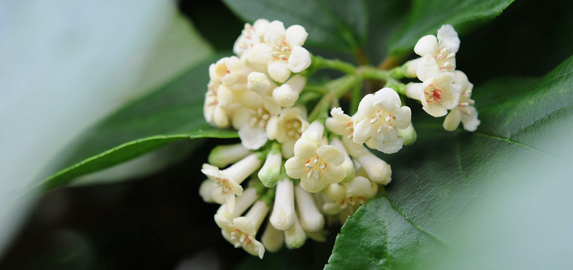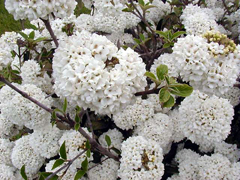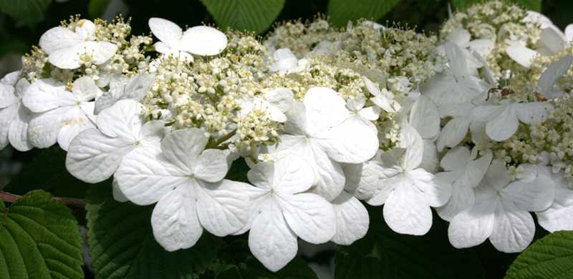
Viburnums bloom in white in the last part of April through early May. Viburnums vary in their height, spread, and style of flower but are similar in preferring sun to part shade and in being disease and pest resistant. While most flowers are unscented, those that are fragrant are wonderfully so. An interesting source of diversity in the viburnums comes with the leaf shape and texture. The fruit is often also of visual interest, with red, to dark purple to black berries, which often serve as an important food source for birds.
Viburnums are part of the Caprifoliaceae family and are related to other shrubs such as the honeysuckles, the abelias, and the weigelas. The viburnums have a wide distribution range that includes both Asia and North America. The Missouri Botanical Garden displays over 50 different species and cultivars in the Viburnum genus. Here are some noteworthy examples:
 As a 2010 addition to the Plants of Merit program, Viburnum dentatum 'Christom' BLUE MUFFIN is a sure winner. It is a compact cultivar, up to five feet tall, producing delicate white flowers in flat-topped clusters in early May. Another viburnum producing a similar flower is V. lantana 'Mohican', or the wayfaringtree viburnum, which can be found growing up to 8 feet tall in the Woodland Garden.
As a 2010 addition to the Plants of Merit program, Viburnum dentatum 'Christom' BLUE MUFFIN is a sure winner. It is a compact cultivar, up to five feet tall, producing delicate white flowers in flat-topped clusters in early May. Another viburnum producing a similar flower is V. lantana 'Mohican', or the wayfaringtree viburnum, which can be found growing up to 8 feet tall in the Woodland Garden.
While V. dentatum and V. lantana tend to produce a ‘lacecap’ type of flower, the double file viburnums, such as Viburnum plicatum f. tomentosum 'Mariesii', produce two rows of flower clusters, with both small and large flowers, along the stem – this is a unique look worth seeing in person. ‘Mariesii’ can be found blooming from the last week of April through the second week of May in the Woodland Garden. In addition, this 10-12 feet shrub is distinctly branched horizontally (giving the plant a layered look).
A third type of viburnum flower is the big puffy ‘snowball,’ such as produced by the cultivar Viburnum 'Eskimo' in the end of April.
Viburnum plants can also produce intoxicatingly fragrant flowers, which attract humans, birds, and butterflies. The Koreanspice viburnum, Viburnum carlesii, offers a glorious, sweet and fresh scent in late April from its pinkish and whitish flowers. The City Garden in our Kemper Demonstration Gardens contains several shrubs of the species, while the April-blooming cultivar ‘Compactum,’ at just 2 ½ to 4 feet tall and wide, can be found in the Fragrance Garden, the Rhododendron Garden and the Woodland Garden. Let your nose follow the heavenly scent.
The fragrant snowball, Viburnum x carlcephalum, yields striking mounds of snow-white flowers that look as if they could be plucked off the bush and thrown at someone. This medium-tall viburnum can be found blooming in the Woodland Garden in mid- to late April.
Some viburnums provide visual interest to the winter garden, whether through evergreen leaves or colorful fruit drupes. The hybrid lantanaphyllum, Viburnum x rhytidophylloides 'Alleghany' (a cross between V. rhytidophyllum and V. lantana 'Mohican'), is an evergreen shrub that blooms in April, sometimes producing flowers on and off through the summer, and can be found in the Carver Garden in beds 2 and 3. Another evergreen that is winter hardy in our area is the Prague viburnum, Viburnum 'Pragense', which also blooms in late April and can be found along the main trail in the Woodland Garden.
While not an evergreen, the tea viburnum, Viburnum setigerum, is a winter beauty nonetheless. Although it blooms much like other viburnums (in late April/early May), the 10-feet tall tea viburnum produces a dramatic display of red fruit that last through most of the winter; fruit yield is high when grown in full sun, such as it is in the Kemper Bird Garden.
We’ve seen that viburnums can produce different flower shapes, can be evergreen or not, and can produce long lasting fruits for winter birds. Viburnums can also distinguish themselves by producing interesting leaves. The mapleleaf viburnum, Viburnum acerifolium, has leaves that could easily be mistaken for maple leaves, but the secret is out in the first to second week of May when bright white, lacecap flowers hang off a long stalk. Catch this masquerading maple growing in the shade of the Woodland Garden.

Several specimen on the Garden grounds are native to Missouri. The arrowwood viburnum, Viburnum dentatum, is among the hardiest viburnums available (to Zone 2). This species can be found blooming during the second week of May or showing its nice red fall color in the Bird Garden and the Woodland Garden. The nannyberry, Viburnum lentago, is a tall shrub, up to 16 feet, that blooms the last week of April through the first week of May and can be found in the Kemper Bird Garden. The blackhaw, Viburnum prunifolium, uniquely places it flowers up above its leaves (while the flowers on many viburnums are nestled); you can see this species in the Bird Garden and Woodland Garden. Our last Missouri native is the rusty blackhaw viburnum, Viburnum rufidulum, named for the rust-colored hairs on the leaf undersides and the stems. The rusty blackhaw also produces a brilliant red fall leaf. Look for this native, which can reach up to 20 feet tall, in the Woodland Garden.
After this walking tour through the Missouri Botanical Garden, you will be well-versed in the variety of the Viburnum genus. Viburnums are a steady addition to the home garden because they have very little pest or disease pressure. Their gorgeous flowers, full-leaved habit, and fall and winter interest can be a valuable staple of your home landscape.